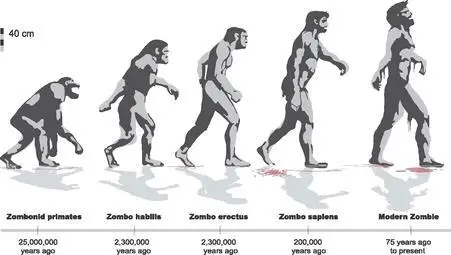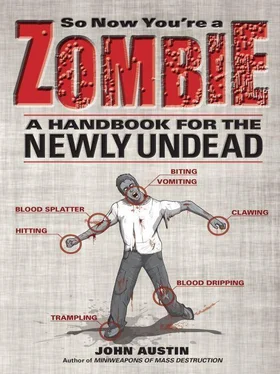Need specifics? Here are just a few of the human distractions from which the z-virus has freed you.
 Taxes.The government may be looking for you, but it’s probably not because your 1040 form was late. If they want it, they can come and get it. You could give a rat’s ass about W2s when you have WWZ on your tainted mind.
Taxes.The government may be looking for you, but it’s probably not because your 1040 form was late. If they want it, they can come and get it. You could give a rat’s ass about W2s when you have WWZ on your tainted mind.
 Work.In past lives, most zombies were chained to demeaning desk jobs and tortured by asshole bosses. Consider this an early retirement. The time for pushing pencils and processing numbers is over—this is the time to burn bridges!
Work.In past lives, most zombies were chained to demeaning desk jobs and tortured by asshole bosses. Consider this an early retirement. The time for pushing pencils and processing numbers is over—this is the time to burn bridges!
 Investments.Remember having to save for your financial future? No, you probably don’t, and that’s for the best. If you’d known that the currency-free existence of a zombie awaited you, you could have just bought that damn sports car!
Investments.Remember having to save for your financial future? No, you probably don’t, and that’s for the best. If you’d known that the currency-free existence of a zombie awaited you, you could have just bought that damn sports car!
 Dieting.South Beach, North Beach… you’ve counted your last calorie. The Brain Beach Diet is not restrictive.
Dieting.South Beach, North Beach… you’ve counted your last calorie. The Brain Beach Diet is not restrictive.
 Hygiene.Body maintenance is now out of your hands, assuming you still have them. Even without a daily grooming routine, you’ll still turn heads, trust us. A slow shamble down any main street will have all the girls and boys screaming.
Hygiene.Body maintenance is now out of your hands, assuming you still have them. Even without a daily grooming routine, you’ll still turn heads, trust us. A slow shamble down any main street will have all the girls and boys screaming.
 Sleep.Party all night long! Zombies don’t need sleep, which allows us to hunt continually, sun up or sun down!
Sleep.Party all night long! Zombies don’t need sleep, which allows us to hunt continually, sun up or sun down!
 Social Networking.As a human, you probably spent much of your time dodging shady acquaintances and their “friend requests.” Now they’ll be the ones avoiding you.
Social Networking.As a human, you probably spent much of your time dodging shady acquaintances and their “friend requests.” Now they’ll be the ones avoiding you.
 Dating.Zeds are not great with relationships; they often mistake attempts at intimacy for an aggressive attack and respond accordingly. Think on the bright side: no more buying flowers or forgetting anniversaries. Good for you, bad for Hallmark.
Dating.Zeds are not great with relationships; they often mistake attempts at intimacy for an aggressive attack and respond accordingly. Think on the bright side: no more buying flowers or forgetting anniversaries. Good for you, bad for Hallmark.
Like zombies throughout history, you roam in the present by the seat of your soiled pants. You have enough trouble just staggering day to day, and probably don’t have any interest in eyeballing your gloomy past. Unfortunately, this fixed mindset can be unhealthy (just like you!). When it comes to sustained destruction, the undead have a mediocre legacy, and without some slight rubbernecking, history can easily repeat itself. We’ve ripped out most of the blood-soaked details, narrowing it down to a skeletal outline.
Prehistoric Zombies
Zombo sapiens stumbled into West Africa roughly 200,000 years ago, hauntingly close to the time of modern man— Homo sapiens . Evidence indicates that in the beginning, breathers and the undead had many similarities. Both species exhibited shoddy communications skills, lacked personal hygiene, and occasionally experimented with cannibalism.

The ancient zeds lacked any zombie culture, though they did exhibit primitive communal dynamics, assembling into hordes , also known as mobs or zombie walks , to hunt down their elusive prey. With relatively few humans to feed on, the ancient zeds were often on the brink of severe decomposition. Once massed together, early Zombo sapiens would rely heavily on the newly reanimated to sniff out hidden human flesh. If a human victim was located, the new recruits’ screams and moans would shatter the stale air and stimulate the starved pack to close in on the bewildered human. Flesh proportions would have to be shared.
Not only was Zombo sapiens’ existence a constant struggle for survival, but also the ancient strain of the z-virus was weak by today’s standards. For both these reasons, our earliest ancestors succeeded in infesting only a minuscule portion of the human population.
Soon, however, populations of Homo sapiens and Zombo sapiens were both on the rise, and it became more difficult to coexist. Uninfected humans invented stone tools, including blunt weapons, and embraced pointlessly aggressive behavioral patterns. Armed and dangerous, the living were now killing zombies for pleasure, a murderous pursuit that previewed humankind’s bloody future.
With an undead genocide underway, the zeds were forced to evolve in order to survive. They developed a persistent hunger for brains that transcended their basic need for nourishment. Other evolutionary adaptations also occurred: increased adrenaline production, and changes in the positioning of the larynx and hyoid bone that improved their projectile vomiting abilities.

The Zombie of Dolni figure is one of the earliest known depictions of the walking undead. Found in the Czech Republic, it has been dated to approximately 28,000 years ago.
With the zeds bullied into aggressiveness, zombie attacks began to rise during the Middle Paleolithic Age, about 150,000 years ago. Our ancestors began to experiment with nocturnal hunting; they could more easily locate breathing humans in the dark, while the defending breathers found it more difficult to see clearly and defend themselves. Soon, with an estimated world population of around 4,000 living and 400 undead, humans were on the brink of extinction. Unfortunately, ancient zombies lacked the ambition to finish the job, a pesky trait many of us suffer from to this day.
The living, on the other hand, took action to ensure their own survival. Around 40,000 B.C., they began to migrate away from zombie-infested territories. Armed with hunting spears and food rations, they divided into three tribes and set off in different directions, thus beginning the exodus from Africa. Hungry and pissed off, the undead straggled behind, feasting on the weak.
The first human tribe set out north, along the Nile River, then navigated into southern Asia. The zombie horde kept pace, shadowing the living, until their sluggish eating habits created an unbridgeable distance between them and their remaining enemies. The humans had outmaneuvered the flesh hunters, and the zombie horde’s fate is unrecorded.
The second tribe crossed the Red Sea, which at that time was 230 feet lower than its present level. Once across the strait, the living continued marching east toward the coastal regions of what is now India. Trying to contain the humans, the zombies pushed them to the Beringia land bridge, which connected Asia to present-day North America. Unfortunately, the pursuers were ill prepared to cross the thousand-mile ice-covered tundra; the freezing conditions rendered their undead bodies useless (see “Cold,” page 62 Cold Remember the Beringia land bridge (see page 6 )? Trying to walk in snow is the least of your worries. The z-virus is very good at regulating your body’s temperature, keeping it steady at around 70° F, but this ability to thermoregulate decreases as temperatures fall. At very low temperatures, the z-virus in you will increase your cellular absorption and decomposition to keep your internal temperature at acceptable levels. Over a long period of time, your muscles will become less responsive and less elastic, leading to coordination problems and slowing down your bodily functions. Your speed may slow by as much as half, and with food more difficult to find and chase, you may decompose to immobility. If you experience an extreme freeze, 15° F or below, your body will be vulnerable to frostbite (a type of decay), but your extremities should continue to function until they fall off. Don’t be alarmed unless your eyelids freeze shut. If you are that cold, eventually your body will completely stiffen up. A zombie body that has been frozen for longer than 48 hours will be use- less when thawed. Water in its cells will expand during freezing and destroy the body’s infrastructure, rendering it limp when warmed up. Warmth Extreme heat (110° F or above) can also affect your body. In some parts of the globe, temperatures can reach an astounding 150° F. How does this affect you? As molecules heat up in a humid environment, they increase their movement, leading to cell breakdown. Depending on the humidity, your rate of decomposition can double as the temperature rises. As a result, your body will need to double its nutritional intake of human flesh (see “Human Buffet,” page 105 ). But if the temperature is high and the humidity low, decomposition will be halted. That is a good thing. Water The lifeguard has been eaten! As you’ve read, moisture and humidity will increase tissue breakdown. So what does swimming do? Zeds that spend too much time in water will experience rapid decomposition. Early signs of this included pruning up of the toxic skin. Stay dry! Avoid prolonged exposure to water, including rain. Also, don’t continually roam sewers or other subterranean domains, as these damp environments will also accelerate decomposition.
), and they were ultimately lost to the elements. It is assumed that the humans survived and completed their journey into North America.
Читать дальше

 Taxes.The government may be looking for you, but it’s probably not because your 1040 form was late. If they want it, they can come and get it. You could give a rat’s ass about W2s when you have WWZ on your tainted mind.
Taxes.The government may be looking for you, but it’s probably not because your 1040 form was late. If they want it, they can come and get it. You could give a rat’s ass about W2s when you have WWZ on your tainted mind.












